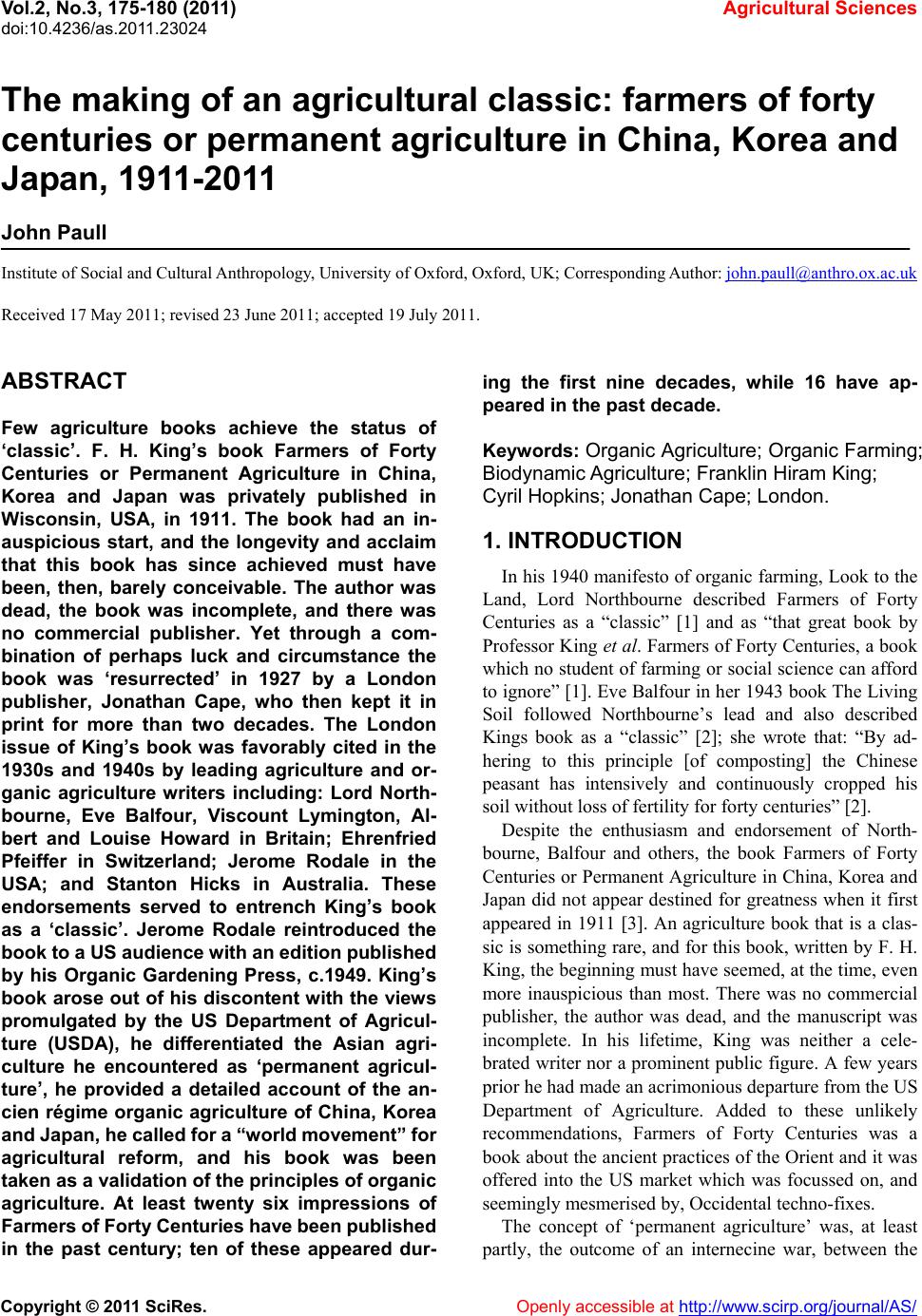 Vol.2, No.3, 175-180 (2011) doi:10.4236/as.2011.23024 Copyright © 2011 SciRes. Openly accessible at http://www.scirp.org/journal/AS/ Agricultural Scienc es The making of an agricultural classic: farmers of forty centuries or permanent agriculture in China, Korea and Japan, 1911-2011 John Paull Institute of Social and Cultural Anthropology, University of Oxford, Oxford, UK; Corresponding Author: john.paull@anthro.ox.ac.uk Received 17 May 2011; revised 23 June 2011; accepted 19 July 2011. ABSTRACT Few agriculture books achieve the status of ‘classic’. F. H. King’s book Farmers of Forty Centuries or Permanent Agriculture in China, Korea and Japan was privately published in Wisconsin, USA, in 1911. The book had an in- auspicious start, and the longevity and acclaim that this book has since achieved must have been, then, barely conceivable. The author was dead, the book was incomplete, and there was no commercial publisher. Yet through a com- bination of perhaps luck and circumstance the book was ‘resurrected’ in 1927 by a London publisher, Jonathan Cape, who then kept it in print for more than two decades. The London issue of King’s book was favorably cited in the 1930s and 1940s by leading agriculture and or- ganic agriculture writers including: Lord North- bourne, Eve Balfour, Viscount Lymington, Al- bert and Louise Howard in Britain; Ehrenfried Pfeiffer in Switzerland; Jerome Rodale in the USA; and Stanton Hicks in Australia. These endorsements served to entrench King’s book as a ‘classic’. Jerome Rodale reintroduced the book to a US audience with an edition published by his Organic Gardening Press, c.1949. King’s book arose out of his discontent with the views promulgated by the US Department of Agricul- ture (USDA), he differentiated the Asian agri- culture he encountered as ‘permanent agricul- ture’, he provided a detailed account of the an- cien régime organic agriculture of China, Korea and Japan, he called for a “world movement” for agricultural reform, and his book was been taken as a validation of the principles of organic agriculture. At least twenty six impressions of Farmers of F orty Centuri es hav e been pu blished in the past century; ten of these appeared dur- ing the first nine decades, while 16 have ap- peared in the past decade. Keywords: Organic Agriculture; Organic Farming; Biodynamic Agriculture; Franklin Hiram King; Cyril Hopkins; Jonathan Cape; London. 1. INTRODUCTION In his 1940 manifesto of organic farming, Look to the Land, Lord Northbourne described Farmers of Forty Centuries as a “classic” [1] and as “that great book by Professor King et al. Farmers of Forty Centuries, a book which no student of farming or social science can afford to ignore” [1]. Eve Balfour in her 1943 book The Living Soil followed Northbourne’s lead and also described Kings book as a “classic” [2]; she wrote that: “By ad- hering to this principle [of composting] the Chinese peasant has intensively and continuously cropped his soil without loss of fertility for forty centuries” [2]. Despite the enthusiasm and endorsement of North- bourne, Balfour and others, the book Farmers of Forty Centuries or Permanent Agriculture in China, Korea and Japan did not appear destined for greatness when it first appeared in 1911 [3]. An agriculture book that is a clas- sic is something rare, and for this bo ok, written by F. H. King, the beginning must have seemed, at the time, even more inauspicious than most. There was no commercial publisher, the author was dead, and the manuscript was incomplete. In his lifetime, King was neither a cele- brated writer nor a prominent public figure. A few years prior he had made an acrimonious departure from the US Department of Agriculture. Added to these unlikely recommendations, Farmers of Forty Centuries was a book about the an cient practices of the Orient and it was offered into the US market which was focussed on, and seemingly mesmerised by, Occidental techno-fixes. The concept of ‘permanent agriculture’ was, at least partly, the outcome of an internecine war, between the 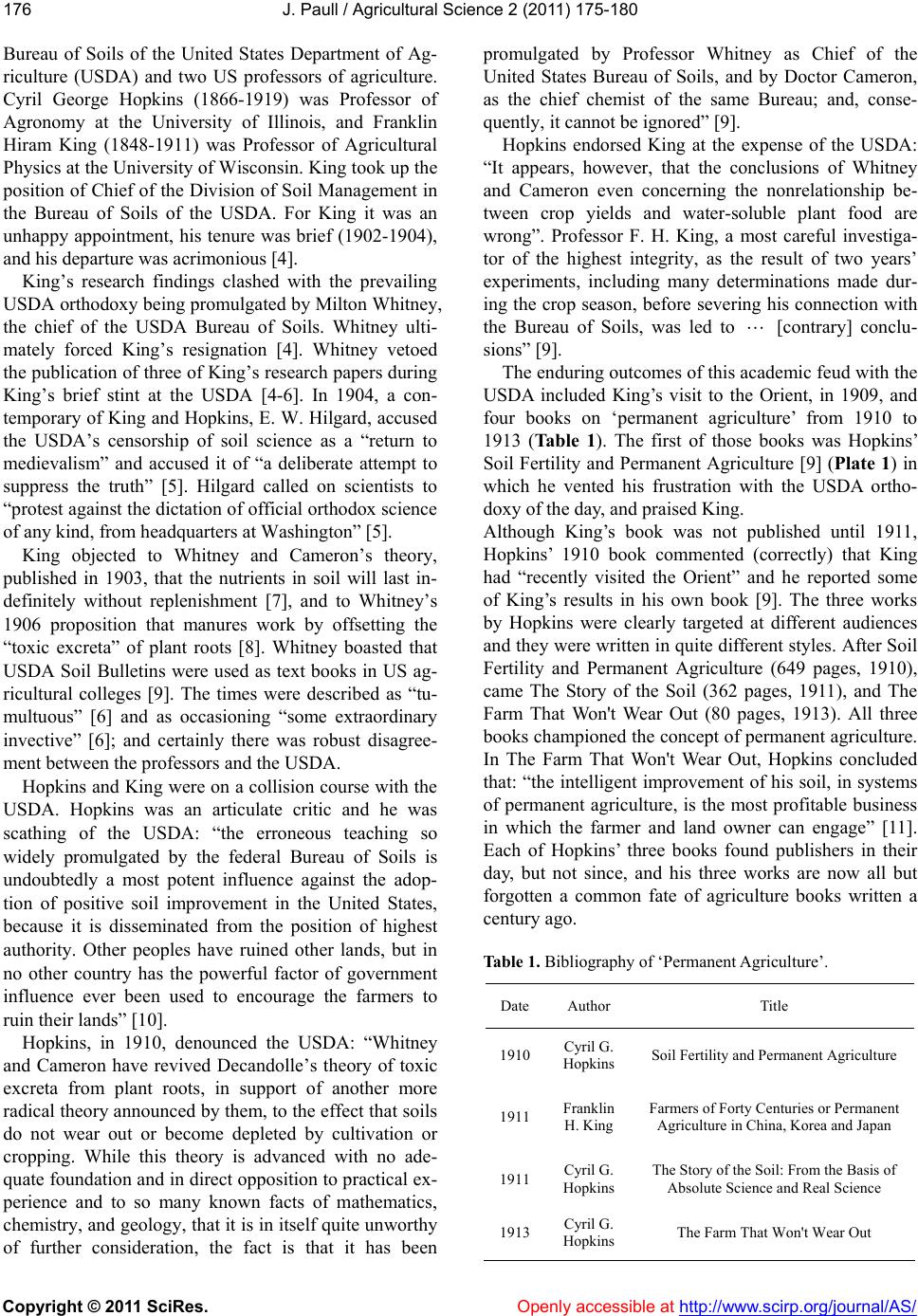 J. Paull / Agricultural Science 2 (2011) 175-180 Copyright © 2011 SciRes. Openly accessible at http://www.scirp.org/journal/AS/ 176 Bureau of Soils of the United States Department of Ag- riculture (USDA) and two US professors of agriculture. Cyril George Hopkins (1866-1919) was Professor of Agronomy at the University of Illinois, and Franklin Hiram King (1848-1911) was Professor of Agricultural Physics at the University of Wisconsin. King took up the position of Chief of the Division of Soil Management in the Bureau of Soils of the USDA. For King it was an unhappy appointment, his tenure was brief (1902-1904), and his departure was acrimonious [4]. King’s research findings clashed with the prevailing USDA orthodoxy being promulgated by Milton Whitney, the chief of the USDA Bureau of Soils. Whitney ulti- mately forced King’s resignation [4]. Whitney vetoed the publication of three of King’s research papers during King’s brief stint at the USDA [4-6]. In 1904, a con- temporary of King and Hopkins, E. W. Hilgard, accused the USDA’s censorship of soil science as a “return to medievalism” and accused it of “a deliberate attempt to suppress the truth” [5]. Hilgard called on scientists to “protest against the d ictation of official orthodox science of any kind, from headquarters at Washington” [5]. King objected to Whitney and Cameron’s theory, published in 1903, that the nutrients in soil will last in- definitely without replenishment [7], and to Whitney’s 1906 proposition that manures work by offsetting the “toxic excreta” of plant roots [8]. Whitney boasted that USDA Soil Bulletins were used as text books in US ag- ricultural colleges [9]. The times were described as “tu- multuous” [6] and as occasioning “some extraordinary invective” [6]; and certainly there was robust disagree- ment between the professors and the USDA. Hopkins and King were on a collision cou rse with the USDA. Hopkins was an articulate critic and he was scathing of the USDA: “the erroneous teaching so widely promulgated by the federal Bureau of Soils is undoubtedly a most potent influence against the adop- tion of positive soil improvement in the United States, because it is disseminated from the position of highest authority. Other peoples have ruined other lands, but in no other country has the powerful factor of government influence ever been used to encourage the farmers to ruin their lands” [10]. Hopkins, in 1910, denounced the USDA: “Whitney and Cameron have revived Decandolle’s theory of toxic excreta from plant roots, in support of another more radical theory announced by them, to the effect that soils do not wear out or become depleted by cultivation or cropping. While this theory is advanced with no ade- quate found ation and in direct oppo sition to practical ex- perience and to so many known facts of mathematics, chemistry, and geology, that it is in itself quite unworthy of further consideration, the fact is that it has been promulgated by Professor Whitney as Chief of the United States Bureau of Soils, and by Doctor Cameron, as the chief chemist of the same Bureau; and, conse- quently, it cannot be ignored” [9]. Hopkins endorsed King at the expense of the USDA: “It appears, however, that the conclusions of Whitney and Cameron even concerning the nonrelationship be- tween crop yields and water-soluble plant food are wrong”. Professor F. H. King, a most careful investiga- tor of the highest integrity, as the result of two years’ experiments, including many determinations made dur- ing the crop season, before severing his connection with the Bureau of Soils, was led to [contrary] conclu- sions” [9 ]. The enduring outcomes of this academic feud with the USDA included King’s visit to the Orient, in 1909, and four books on ‘permanent agriculture’ from 1910 to 1913 (Ta ble 1). The first of those books was Hopkins’ Soil Fertility and Permanent Agriculture [9] (Plate 1) in which he vented his frustration with the USDA ortho- doxy of the day, and praised King. Although King’s book was not published until 1911, Hopkins’ 1910 book commented (correctly) that King had “recently visited the Orient” and he reported some of King’s results in his own book [9]. The three works by Hopkins were clearly targeted at different audiences and they were written in quite different styles. After Soil Fertility and Permanent Agriculture (649 pages, 1910), came The Story of the Soil (362 pages, 1911), and The Farm That Won't Wear Out (80 pages, 1913). All three books championed the concept of permanent agriculture. In The Farm That Won't Wear Out, Hopkins concluded that: “the intelligent improvement of his soil, in systems of permanent agriculture, is the most profitable business in which the farmer and land owner can engage” [11]. Each of Hopkins’ three books found publishers in their day, but not since, and his three works are now all but forgotten a common fate of agriculture books written a century ago. Table 1. Bibliography of ‘Permanent Agriculture’. Date Author Title 1910 Cyril G. Hopkins Soil Fertility and Perma nent Agriculture 1911 Franklin H. King Farmers of Forty Centuries or Permanent Agriculture in China, Korea and Japan 1911 Cyril G. Hopkins The Story of the Soil: From the Basis of Absolute Science and Real Science 1913 Cyril G. Hopkins The Farm That Won't Wear Out 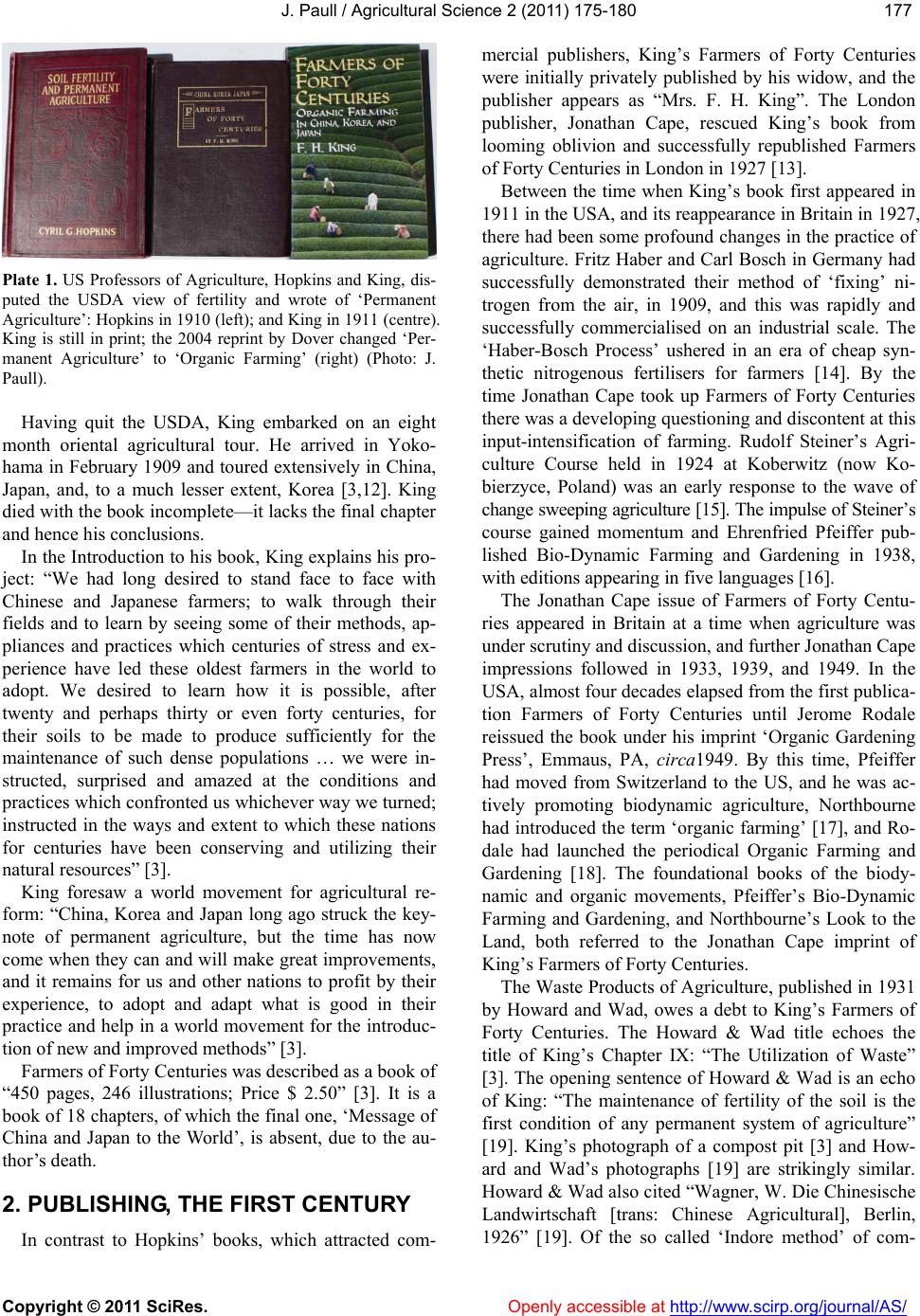 J. Paull / Agricultural Science 2 (2011) 175-180 Copyright © 2011 SciRes. Openly accessible at http://www.scirp. o rg/journal/AS/ 177177 Plate 1. US Professors of Agriculture, Hopkins and King, dis- puted the USDA view of fertility and wrote of ‘Permanent Agriculture’: Hopkins in 1910 (left); and King in 1911 (centre). King is still in print; the 2004 reprint by Dover changed ‘Per- manent Agriculture’ to ‘Organic Farming’ (right) (Photo: J. Paull). Having quit the USDA, King embarked on an eight month oriental agricultural tour. He arrived in Yoko- hama in February 1909 and toured extensively in China, Japan, and, to a much lesser extent, Korea [3,12]. King died with the book in complete—it lack s the fin al chapter and hence his conclusions. In the Introduction to his book, King explains his pro- ject: “We had long desired to stand face to face with Chinese and Japanese farmers; to walk through their fields and to learn by seeing some of their methods, ap- pliances and practices which centuries of stress and ex- perience have led these oldest farmers in the world to adopt. We desired to learn how it is possible, after twenty and perhaps thirty or even forty centuries, for their soils to be made to produce sufficiently for the maintenance of such dense populations … we were in- structed, surprised and amazed at the conditions and practices which confronted us whichever way we turned; instructed in the ways and extent to which these nations for centuries have been conserving and utilizing their natural resources” [3]. King foresaw a world movement for agricultural re- form: “China, Korea and Japan long ago struck the key- note of permanent agriculture, but the time has now come when they can and will make great improvements, and it remains for us and other nations to profit by their experience, to adopt and adapt what is good in their practice and help in a world movement for the introduc- tion of new and improved methods” [3]. Farmers of Forty Centuries was described as a book of “450 pages, 246 illustrations; Price $ 2.50” [3]. It is a book of 18 chapters, of which the final one, ‘Message of China and Japan to the World’, is absent, due to the au- thor’s death. 2. PUBLISHING, THE FIRST CENTURY In contrast to Hopkins’ books, which attracted com- mercial publishers, King’s Farmers of Forty Centuries were initially privately published by his widow, and the publisher appears as “Mrs. F. H. King”. The London publisher, Jonathan Cape, rescued King’s book from looming oblivion and successfully republished Farmers of Forty Centuries in London in 1927 [13]. Between the time when King’s book first appeared in 1911 in the USA, and its reapp earance in Britain in 19 27, there had been some profound changes in the practice of agriculture. Fritz Haber and Carl Bosch in Germany had successfully demonstrated their method of ‘fixing’ ni- trogen from the air, in 1909, and this was rapidly and successfully commercialised on an industrial scale. The ‘Haber-Bosch Process’ ushered in an era of cheap syn- thetic nitrogenous fertilisers for farmers [14]. By the time Jonathan Cape took up Farmers of Forty Centuries there was a developing questioning and discontent at this input-intensification of farming. Rudolf Steiner’s Agri- culture Course held in 1924 at Koberwitz (now Ko- bierzyce, Poland) was an early response to the wave of change sweeping agr iculture [15]. The impuls e of Steiner’s course gained momentum and Ehrenfried Pfeiffer pub- lished Bio-Dynamic Farming and Gardening in 1938, with editions appearing in five languages [16]. The Jonathan Cape issue of Farmers of Forty Centu- ries appeared in Britain at a time when agriculture was under scrutiny and discussion, and further Jonathan Cape impressions followed in 1933, 1939, and 1949. In the USA, almost four decades elapsed from the first publica- tion Farmers of Forty Centuries until Jerome Rodale reissued the book under his imprint ‘Organic Gardening Press’, Emmaus, PA, circa1949. By this time, Pfeiffer had moved from Switzerland to the US, and he was ac- tively promoting biodynamic agriculture, Northbourne had introduced the term ‘organic farming’ [17], and Ro- dale had launched the periodical Organic Farming and Gardening [18]. The foundational books of the biody- namic and organic movements, Pfeiffer’s Bio-Dynamic Farming and Gardening, and Northbourne’s Look to the Land, both referred to the Jonathan Cape imprint of King’s Farmers of Forty Centuries. The Waste Products of Agriculture, pub lished in 1931 by Howard and Wad, owes a debt to King’s Farmers of Forty Centuries. The Howard & Wad title echoes the title of King’s Chapter IX: “The Utilization of Waste” [3]. The opening sentence of Howard & Wad is an echo of King: “The maintenance of fertility of the soil is the first condition of any permanent system of agriculture” [19]. King’s photograph of a compost pit [3] and How- ard and Wad’s photographs [19] are strikingly similar. Howard & Wad also cited “Wagner, W. Die Chinesische Landwirtschaft [trans: Chinese Agricultural], Berlin, 1926” [19]. Of the so called ‘Indore method’ of com- 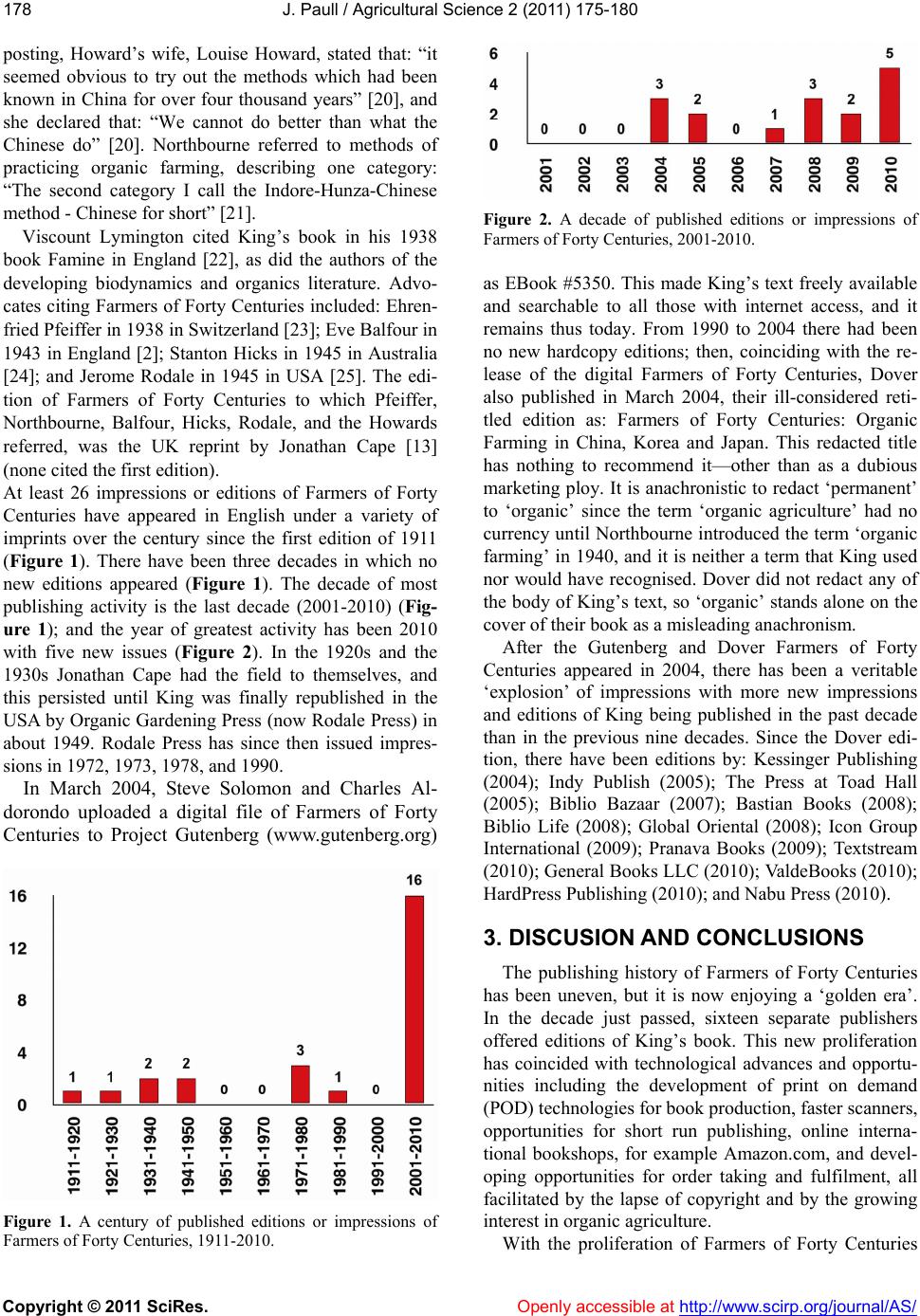 J. Paull / Agricultural Science 2 (2011) 175-180 Copyright © 2011 SciRes. Openly accessible at http://www.scirp.org/journal/AS/ 178 posting, Howard’s wife, Louise Howard, stated that: “it seemed obvious to try out the methods which had been known in China for over four thousand years” [20], and she declared that: “We cannot do better than what the Chinese do” [20]. Northbourne referred to methods of practicing organic farming, describing one category: “The second category I call the Indore-Hunza-Chinese method - Chinese for short” [21]. Viscount Lymington cited King’s book in his 1938 book Famine in England [22], as did the authors of the developing biodynamics and organics literature. Advo- cates citing Farmers of Forty Centuries included: Ehren- fried Pfeiffer in 1938 in Switzerland [23]; Eve Balfour in 1943 in England [2]; Stanton Hicks in 1945 in Australia [24]; and Jerome Rodale in 1945 in USA [25]. The edi- tion of Farmers of Forty Centuries to which Pfeiffer, Northbourne, Balfour, Hicks, Rodale, and the Howards referred, was the UK reprint by Jonathan Cape [13] (none cited the first edition). At least 26 impressions or editions of Farmers of Forty Centuries have appeared in English under a variety of imprints over the century since the first edition of 1911 (Figure 1). There have been three decades in which no new editions appeared (Figure 1). The decade of most publishing activity is the last decade (2001-2010) (Fig- ure 1); and the year of greatest activity has been 2010 with five new issues (Figure 2). In the 1920s and the 1930s Jonathan Cape had the field to themselves, and this persisted until King was finally republished in the USA by Organic Gardening Press (now Rodale Press) in about 1949. Rodale Press has since then issued impres- sions in 1972, 1973, 1978, and 1990. In March 2004, Steve Solomon and Charles Al- dorondo uploaded a digital file of Farmers of Forty Centuries to Project Gutenberg (www.gutenberg.org) Figure 1. A century of published editions or impressions of Farmers of Forty Centuries, 1911-2010. Figure 2. A decade of published editions or impressions of Farmers of Forty Centuries, 2001-2010. as EBook #5350. This made King’s text freely available and searchable to all those with internet access, and it remains thus today. From 1990 to 2004 there had been no new hardcopy editions; then, coinciding with the re- lease of the digital Farmers of Forty Centuries, Dover also published in March 2004, their ill-considered reti- tled edition as: Farmers of Forty Centuries: Organic Farming in China, Korea and Japan. This redacted title has nothing to recommend it—other than as a dubious marketing ploy. It is anachronistic to redact ‘permanent’ to ‘organic’ since the term ‘organic agriculture’ had no currency until Northbourne introdu ced the term ‘organic farming’ in 1940, and it is neither a term that King used nor would have recognised. Dover did not redact any of the body of King’s text, so ‘organic’ stands alone on the cover of their book as a misleading anachronism. After the Gutenberg and Dover Farmers of Forty Centuries appeared in 2004, there has been a veritable ‘explosion’ of impressions with more new impressions and editions of King being published in the past decade than in the previous nine decades. Since the Dover edi- tion, there have been editions by: Kessinger Publishing (2004); Indy Publish (2005); The Press at Toad Hall (2005); Biblio Bazaar (2007); Bastian Books (2008); Biblio Life (2008); Global Oriental (2008); Icon Group International (2009); Pranava Books (2009); Textstream (2010); Gener al Books LLC (2010); ValdeBooks (2010); HardPress Publishing (2010); and Nabu Press (2010). 3. DISCUSION AND CONCLUSIONS The publishing history of Farmers of Forty Centuries has been uneven, but it is now enjoying a ‘golden era’. In the decade just passed, sixteen separate publishers offered editions of King’s book. This new proliferation has coincided with technological advances and opportu- nities including the development of print on demand (POD) technol ogi es for book producti o n, faster scanners, opportunities for short run publishing, online interna- tional bookshops, for example Amazon.com, and devel- oping opportunities for order taking and fulfilment, all facilitated by the lapse of copyright and by the growing interest in organic agriculture. With the proliferation of Farmers of Forty Centuries 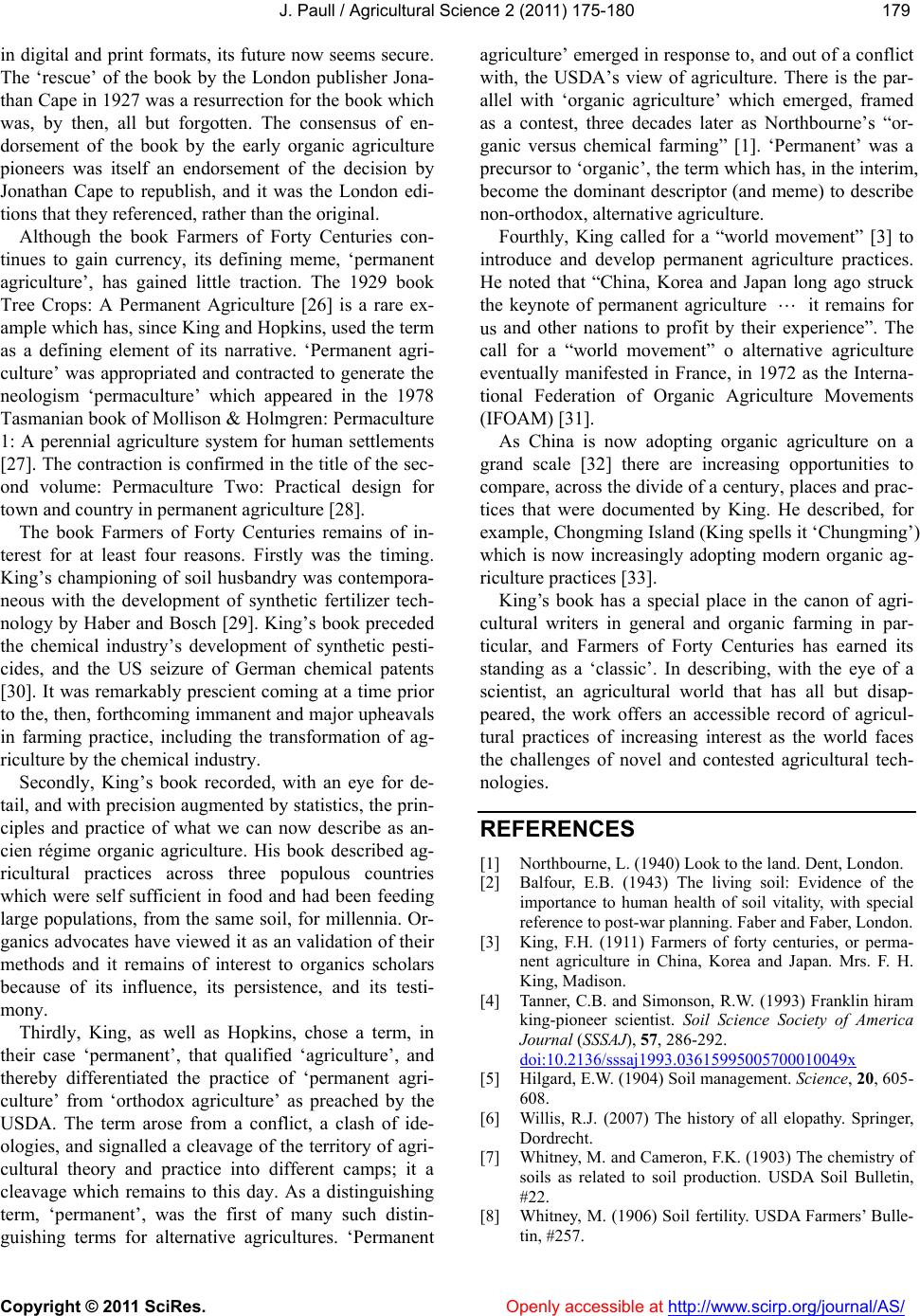 J. Paull / Agricultural Science 2 (2011) 175-180 Copyright © 2011 SciRes. Openly accessible at http://www.scirp. o rg/journal/AS/ 179179 in digital and print formats, its future now seems secure. The ‘rescue’ of the book by the London publisher Jona- than Cape in 1927 was a resur rection for the book wh ich was, by then, all but forgotten. The consensus of en- dorsement of the book by the early organic agriculture pioneers was itself an endorsement of the decision by Jonathan Cape to republish, and it was the London edi- tions that they referenced, rather than the original. Although the book Farmers of Forty Centuries con- tinues to gain currency, its defining meme, ‘permanent agriculture’, has gained little traction. The 1929 book Tree Crops: A Permanent Agriculture [26] is a rare ex- ample which has, since King and Hopkins, used the term as a defining element of its narrative. ‘Permanent agri- culture’ was appropriated and contracted to generate the neologism ‘permaculture’ which appeared in the 1978 Tasmanian book of Mollison & Holmgren: Permaculture 1: A perennial agriculture system for human settlements [27]. The contraction is co nfirmed in the title of the sec- ond volume: Permaculture Two: Practical design for town and country in permanent agriculture [28]. The book Farmers of Forty Centuries remains of in- terest for at least four reasons. Firstly was the timing. King’s championing of soil husbandry was contempora- neous with the development of synthetic fertilizer tech- nology by Haber and Bosch [29]. King’s book preceded the chemical industry’s development of synthetic pesti- cides, and the US seizure of German chemical patents [30]. It was remarkably prescient coming at a time prior to the, then, forthcoming immanent and major upheavals in farming practice, including the transformation of ag- riculture by the chemical industry. Secondly, King’s book recorded, with an eye for de- tail, and with precision augmented by statistics, the prin- ciples and practice of what we can now describe as an- cien régime organic agriculture. His book described ag- ricultural practices across three populous countries which were self sufficient in food and had been feeding large populations, from the same soil, for millennia. Or- ganics advocates have viewed it as an validation of their methods and it remains of interest to organics scholars because of its influence, its persistence, and its testi- mony. Thirdly, King, as well as Hopkins, chose a term, in their case ‘permanent’, that qualified ‘agriculture’, and thereby differentiated the practice of ‘permanent agri- culture’ from ‘orthodox agriculture’ as preached by the USDA. The term arose from a conflict, a clash of ide- ologies, and signalled a cleavage of the territory of agri- cultural theory and practice into different camps; it a cleavage which remains to this day. As a distinguishing term, ‘permanent’, was the first of many such distin- guishing terms for alternative agricultures. ‘Permanent agriculture’ emerged in response to, and out of a conflict with, the USDA’s view of agriculture. There is the par- allel with ‘organic agriculture’ which emerged, framed as a contest, three decades later as Northbourne’s “or- ganic versus chemical farming” [1]. ‘Permanent’ was a precursor to ‘organic’, the term which has, in the interim, become the dominant descriptor (and meme) to describe non-orthodox, alternative agriculture. Fourthly, King called for a “world movement” [3] to introduce and develop permanent agriculture practices. He noted that “China, Korea and Japan long ago struck the keynote of permanent agriculture it remains for us and other nations to profit by their experience”. The call for a “world movement” o alternative agriculture eventually manifested in France, in 1972 as the Interna- tional Federation of Organic Agriculture Movements (IFOAM) [31]. As China is now adopting organic agriculture on a grand scale [32] there are increasing opportunities to compare, across the divide of a century, places and prac- tices that were documented by King. He described, for example, Chongming Island (King spells it ‘Chungming’) which is now increasingly adopting modern organic ag- riculture practices [33]. King’s book has a special place in the canon of agri- cultural writers in general and organic farming in par- ticular, and Farmers of Forty Centuries has earned its standing as a ‘classic’. In describing, with the eye of a scientist, an agricultural world that has all but disap- peared, the work offers an accessible record of agricul- tural practices of increasing interest as the world faces the challenges of novel and contested agricultural tech- nologies. REFERENCES [1] Northbourne, L. (1940) Look to the land. Dent, London. [2] Balfour, E.B. (1943) The living soil: Evidence of the importance to human health of soil vitality, with special reference to post-war planning. Faber and Faber, London. [3] King, F.H. (1911) Farmers of forty centuries, or perma- nent agriculture in China, Korea and Japan. Mrs. F. H. King, Madison. [4] Tanner, C.B. and Simonson, R.W. (1993) Franklin hiram king-pioneer scientist. Soil Science Society of America Journal (SSSAJ), 57, 286-292. doi:10.2136/sssaj1993.03615995005700010049x [5] Hilgard, E.W. (1904) Soil management. Science, 20, 605- 608. [6] Willis, R.J. (2007) The history of all elopathy. Springer, Dordrecht. [7] Whitney, M. and Cameron, F.K. (1903) The chemistry of soils as related to soil production. USDA Soil Bulletin, #22. [8] Whitney, M. (1906) Soil fertility. USDA Farmers’ Bulle- tin, #257. 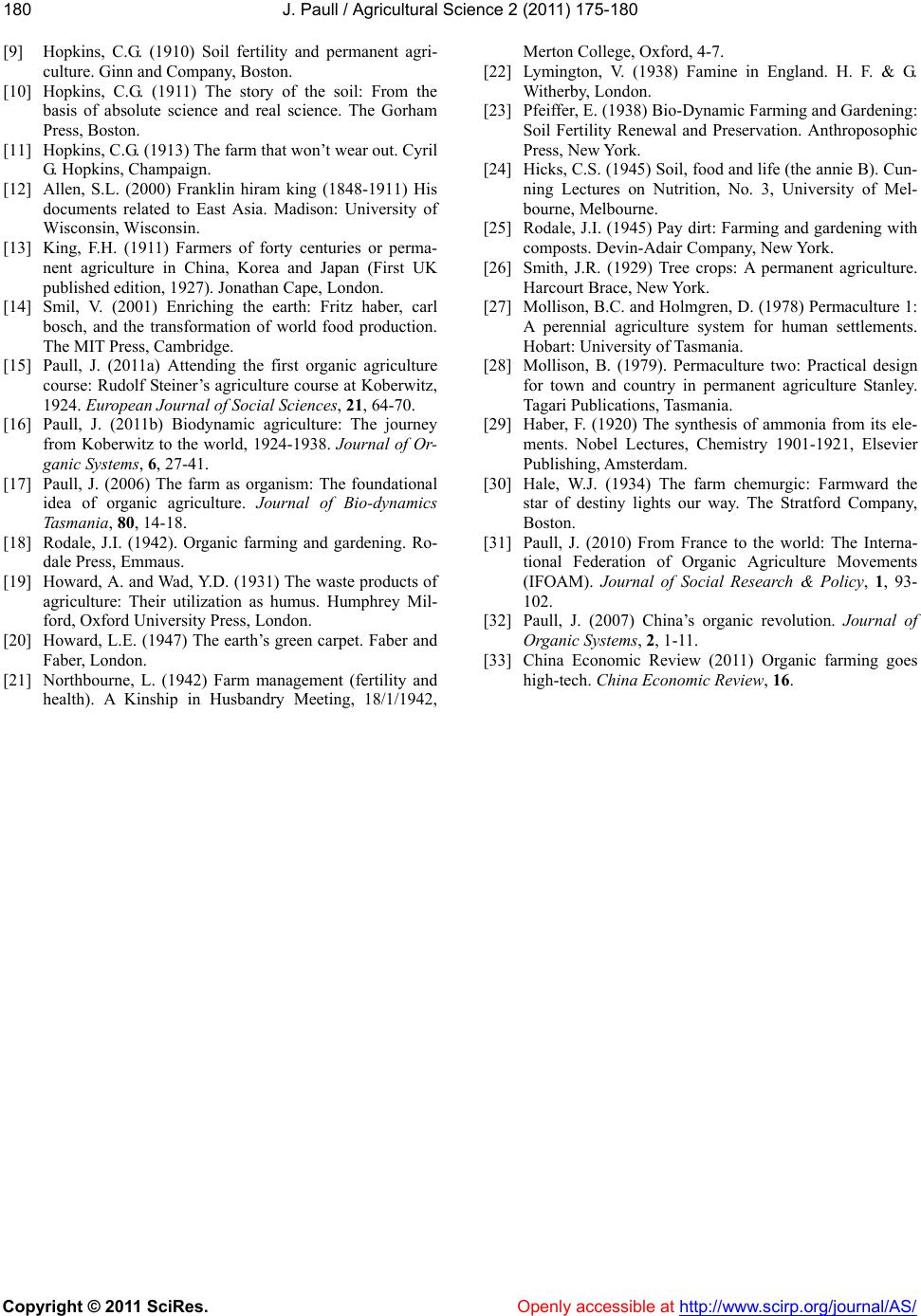 J. Paull / Agricultural Science 2 (2011) 175-180 Copyright © 2011 SciRes. http://www.scirp.org/journal/AS/Openly accessible at 180 [9] Hopkins, C.G. (1910) Soil fertility and permanent agri- culture. Ginn and Company, Boston. [10] Hopkins, C.G. (1911) The story of the soil: From the basis of absolute science and real science. The Gorham Press, Boston. [11] Hopkins, C.G. (1913) The farm that won’t wear out. Cyril G. Hopkins, Champaign. [12] Allen, S.L. (2000) Franklin hiram king (1848-1911) His documents related to East Asia. Madison: University of Wisconsin, Wisconsin. [13] King, F.H. (1911) Farmers of forty centuries or perma- nent agriculture in China, Korea and Japan (First UK published edition, 1927). Jonathan Cape, London. [14] Smil, V. (2001) Enriching the earth: Fritz haber, carl bosch, and the transformation of world food production. The MIT Press, Cambridge. [15] Paull, J. (2011a) Attending the first organic agriculture course: Rudolf Steiner ’s agriculture course at Koberwitz, 1924. European Journal of Social Sciences, 21, 64-70. [16] Paull, J. (2011b) Biodynamic agriculture: The journey from Koberwitz to the world, 1924-1938. Journal of Or- ganic Systems, 6, 27-41. [17] Paull, J. (2006) The farm as organism: The foundational idea of organic agriculture. Journal of Bio-dynamics Tasmania, 80, 14-18. [18] Rodale, J.I. (1942). Organic farming and gardening. Ro- dale Press, Emmaus. [19] Howard, A. and Wad, Y.D. (1931) The waste products of agriculture: Their utilization as humus. Humphrey Mil- ford, Oxford University Press, London. [20] Howard, L.E. (1947) The earth’s green carpet. Faber and Faber, London. [21] Northbourne, L. (1942) Farm management (fertility and health). A Kinship in Husbandry Meeting, 18/1/1942, Merton College, Oxford, 4-7. [22] Lymington, V. (1938) Famine in England. H. F. & G. Witherby, London. [23] Pfeiffer, E. (1938) Bio-Dynamic Farming and Gardening: Soil Fertility Renewal and Preservation. Anthroposophic Press, New York. [24] Hicks, C.S. (1945) Soil, food and life (the annie B). Cun- ning Lectures on Nutrition, No. 3, University of Mel- bourne, Melbourne. [25] Rodale, J.I. (1945) Pay dirt: Farming and gardening with composts. Devin-Adair Company, New York. [26] Smith, J.R. (1929) Tree crops: A permanent agriculture. Harcourt Brace, New York. [27] Mollison, B.C. and Holmgren, D. (1978) Permaculture 1: A perennial agriculture system for human settlements. Hobart: University of Tasmania. [28] Mollison, B. (1979). Permaculture two: Practical design for town and country in permanent agriculture Stanley. Tagari Publications, Tasmania. [29] Haber, F. (1920) The synthesis of ammonia from its ele- ments. Nobel Lectures, Chemistry 1901-1921, Elsevier Publishing, Amsterdam. [30] Hale, W.J. (1934) The farm chemurgic: Farmward the star of destiny lights our way. The Stratford Company, Boston. [31] Paull, J. (2010) From France to the world: The Interna- tional Federation of Organic Agriculture Movements (IFOAM). Journal of Social Research & Policy, 1, 93- 102. [32] Paull, J. (2007) China’s organic revolution. Journal of Organic Systems, 2, 1-11. [33] China Economic Review (2011) Organic farming goes high-tech. China Economic Review, 16.
|